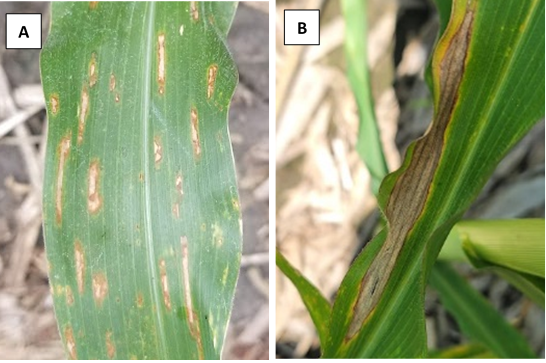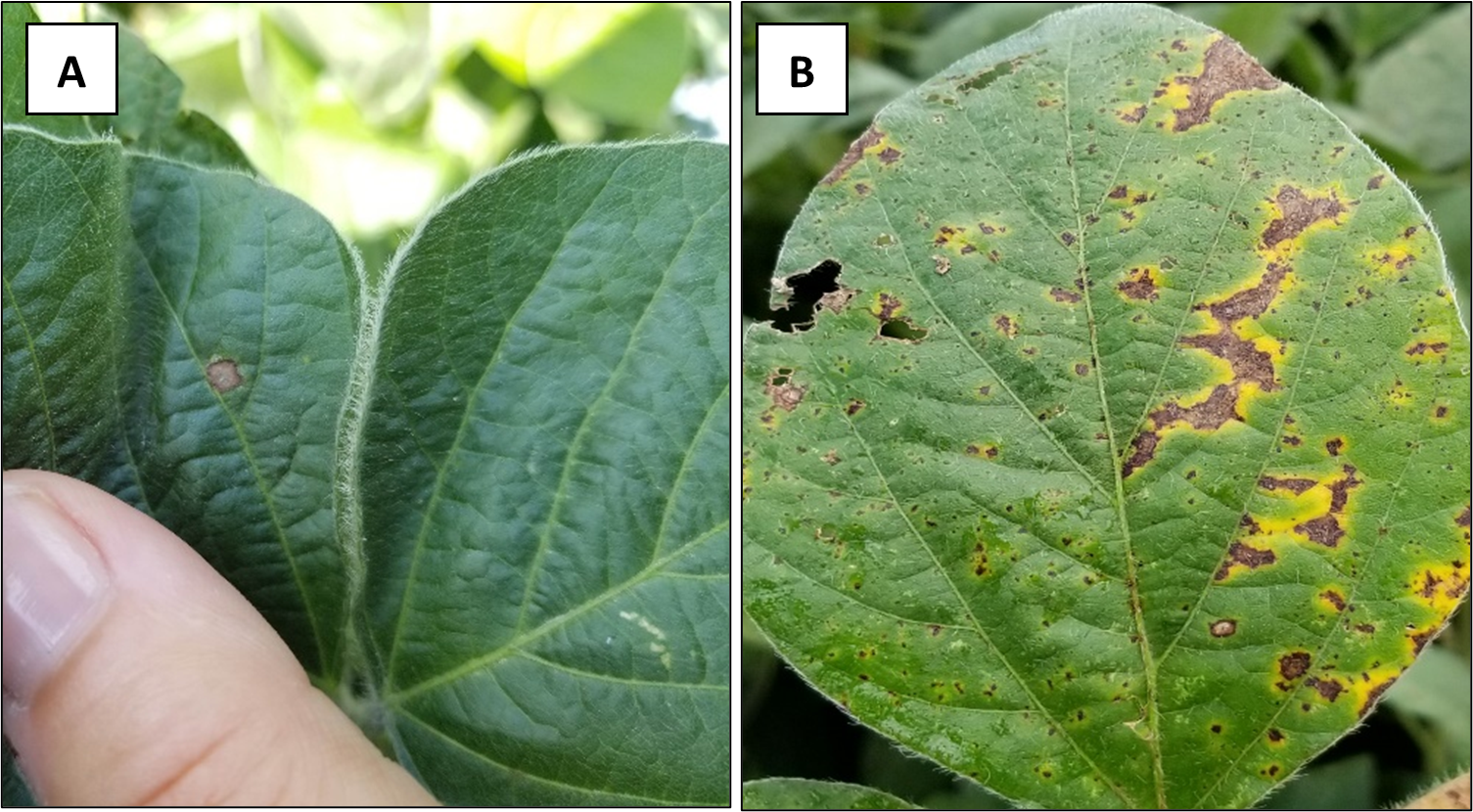It is important to continue to scout for diseases in both corn and soybeans. Recent rains have created favorable environmental conditions for the development of foliar diseases in both crops. In our scouting rounds this week we have found our first few tar spot lesions in the lower canopy of corn (see map). The fields where tar spot was found have had plenty of moisture the last few weeks and the corn is at tassel. In addition, I did find some northern corn leaf blight in a continuous, no-till field.
Our soybean fields are approaching flowering and we have yet to find any active foliar diseases. There are a few reports of patches and poorly growing stands of soybean. In these areas it is important to determine if there’s an abiotic issue, like water logged soil and anerobic conditions, or if a root pathogens or soybean cyst nematode are the cause of poor root development. The best way to confirm is to send samples into the Purdue Plant and Pest Diagnostic Lab (PPDL). When sampling these areas, please dig plants from the edge of the area of concern and collect both healthy and unhealthy plants and roots.
The most frequent question I have received is, “Should we make a fungicide application?”
My response – What diseases are you finding in your field?
What is your hybrid/variety susceptibility and field history?
What growth stage?
Are you irrigating?
A fungicide application can be effective at reducing disease and protecting yield, but there are a number of factors that need to consider: the field history/previous crop, the amount of disease present in the field, hybrid/variety susceptibility, weather conditions, the value of the crop, and cost of fungicide application.

Figure 1. Foliar diseases to watch for in corn A. gray leaf spot, B. northern corn leaf blight. (Photo Credit: Darcy Telenko)

Figure 2. Foliar diseases to watch for in soybean A. frogeye leaf spot, B Septoria brown spot. (Photo Credit: Darcy Telenko)
Tar Spot: Tar spot continues to be a concern this season. My team has found a few active tar spot lesions and we have confirmed tar spot on samples sent in to the PPDL (image below). In all these samples the severity is extremely low, just one lesion on each leaf from the lower canopy. These early tar spot detections are like finding a needle in the haystack and required intensive scouting, but as the disease progresses it will be easier to find as the number of spots increase and it moves up the canopy. I would focus scouting efforts the early planted fields that have had a history of the disease. This find means scout and keep an eye out. I would wait to make an informed decision on fungicide application until you find active disease in the corn canopy. Our research has shown that making an application after first detecting the tar spot in the lower canopy is effective. Where we have seen fungicide failure is when the disease has moved up in the upper canopy and greater than 5% of the ear leaf is already showing symptoms at that point it is probably too late to slow it down.
We have confirmed tar spot in LaPorte, Porter and Marshall counties. Tar spot had previously been found in 86 counties (gray color) in Indiana, with the northern part of the state most at risk where we have higher inoculum. We will continue to monitor and update as the season continues.
We are working hard to try to understand this new disease to minimize losses. The good news is that we have a number of fungicides are highly efficacious against tar spot here in Indiana when applied from tassel (VT) to R2 (milk). I would recommend picking a product with multiple modes of action. The national Corn Disease Working Group has developed a very useful fungicide efficacy table for corn diseases (see link below). We will continue keeping a close eye on tar spot. I am interested in adding more locations in surrounding counties in northern Indiana if it is active in your field; please contact me if you suspect a field has tar spot please or send a sample to the Purdue PPDL for confirmation.

Figure 3. Tar spot lesions on corn in lower canopy, close-up of the stroma formed on the leaf and tar spot map for July 11, 2023. (Photo Credits: Morgan Goodnight and Darcy Telenko)
summary of our timing trial in Indiana from 2019 to 2021 shows that application of fungicide (Trivapro 13.7 fl oz/A) between the tassel (VT/R1) and milk (R3) growth stages were the most effective at reducing tar spot disease severity (gray bars ), while VT to dough (R4) protected yield and offered the greatest partial return (green bars ) (Fig. 4). These were compared to a location that did not have tar spot where all fungicide application timings did not provide a return on investment (ROI) for the fungicide application.

Figure 4. Tar spot severity and partial net-return based on fungicide application timing in a field with history of severe tar spot. Citation: Ross, T. J. et al. In Press. Investigations into economic returns resulting from foliar fungicides and application timing on management of tar spot in Indiana hybrid corn. Accepted to Plant Disease.
Both gray leaf spot and northern corn leaf blight disease may also start to be found in corn across the state. It is going to be extremely important to be out scouting, especially if you are trying to make a decision on a fungicide application.
Scout for Gray leaf spot in the lower to mid canopy. The lesions are light tan in color and generally narrow and rectangular, and can be as long as 2 inches. As the lesions age they turn grey in color and are delimited by leaf veins (Fig. 1). This annual disease is one of the most important foliar diseases in Indiana. Hybrid susceptibility and weather will have the greatest impact on the severity in a field. Fungicide options that are available for gray leaf spot would be a cost-effective application in fields that have a history of disease and planted to susceptible hybrids in no-till or reduced-till system. As a reminder, fungicide applications add an additional cost to corn production. Therefore, economic factors and other disease issues need to be considered before deciding to apply a fungicide to manage gray leaf spot. Previous research has determined the best time to apply fungicides in preventing yield loss with the most economic return occurs when fungicides are applied in response to disease at tasseling (VT) through early silking (R1).
As a reminder the field history, disease activity, hybrid susceptibility, weather conditions, the value of corn and soybean, and cost of fungicide application are factors that should be considered in making a decision to apply a foliar fungicide. Several fungicides are available to help manage these foliar diseases with a recommended application occurring at late vegetative stages through R1 in corn, and R1 to R4 in soybean for white mold and R3 in soybean for frogeye leaf spot.
Resources:
- Fungicide efficacy table for corn diseases: https://cropprotectionnetwork.org/publications/fungicide-efficacy-for-control-of-corn-diseases
- Fungicide efficacy table for soybean foliar diseases: https://cropprotectionnetwork.org/publications/fungicide-efficacy-for-control-of-soybean-foliar-diseases
Purdue Field Crop Pathology Website with current maps https://indianafieldcroppathology.com/
As a reminder due to the need to monitor both southern rust and tar spot in Indiana, there will be no charge for samples submitted to the PPDL for diagnostic confirmation. This service is made possible through research supported by the Indiana Corn Marketing Council. Please feel free to contact me (dtelenko@purdue.edu) or the PPDL (ppdl-samples@purdue.edu) with any major disease issues you may have this season.



